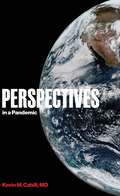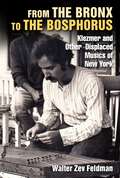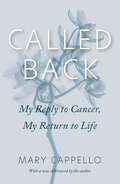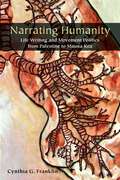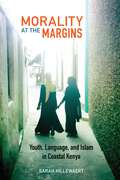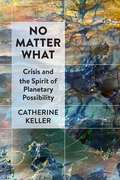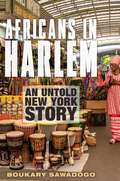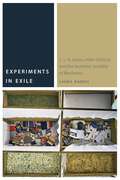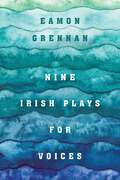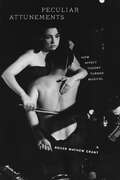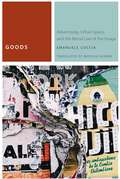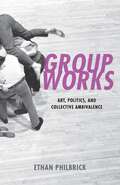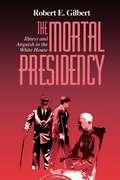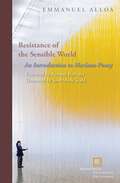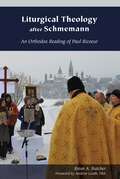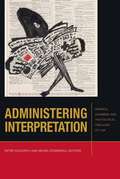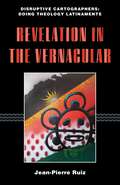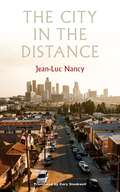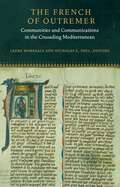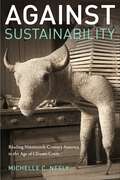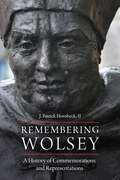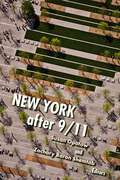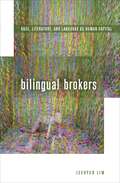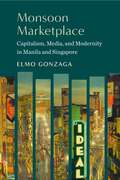- Table View
- List View
The Irreversible Decline of Eddie Socket
by John WeirBefore the onset of his irreversible decline, Eddie Socket always suspected he was on the verge of something. Now that “something” has arrived in the form of Merrit Mather, an attractive older gentleman of impeccable taste in everything from sweaters to his numerous sexual conquests. That Merrit happens to be the lover of Eddie’s agitated boss, Saul, hardly fazes the smitten Eddie; that the elusive Merrit loses interest in Eddie with dizzying speed hardly dims his ardor. While Eddie continues his futile chase, he finds solace in his roommate, Polly, involved in her own implausible affair with a self-involved banker. Both Eddie and Polly eventually conclude that solitude is their best option. But even that is not possible as Eddie finds his life taking an unexpected turn—a turn that that serves as the catalyst for Eddie, love-ravaged Polly, and the indomitable Saul to reclaim their lives.First published in 1989 and winner of the 1990 Lambda Literary Award for Best Gay Debut Novel, The Irreversible Decline of Eddie Socket is one of the first novels to respond to the global AIDS crisis. A comedy of absurdist horror, it weaponizes the comic as a way of intensifying the tragic aspects of AIDS, which were especially acute in the early 1980s, and the scars of which are still visible today.
Perspectives in a Pandemic (International Humanitarian Affairs)
by Kevin M. Cahill M.D.Perspectives in a Pandemic is a series of enlightening essays written by Kevin M. Cahill, M.D., providing a unique insight into the early phase of the COVID-19 pandemic. Dr. Cahill draws on his extensive experiences in earlier epidemics, natural disasters, and armed conflicts to offer lessons, wisdom, guidance, and support to frontline workers. While he wrote the essays as weekly reflections in the early months of the pandemic for the thousands of humanitarian-relief workers he has trained around the world, this book is a must-read for anyone seeking to understand and make some sense of the complexities and chaos inevitable in a pandemic.
From the Bronx to the Bosphorus: Klezmer and Other Displaced Musics of New York
by Walter Zev FeldmanDiscover the vibrant journey of music from New York’s melting pot to the mystical shores of the BosphorusFrom the Bronx to the Bosphorus explores the vibrant, yet largely concealed, musical culture of New York, tracing its origins to a period when the city served as a crucible for immigrants and their diverse musical expressions. Walter Zev Feldman chronicles his journey through the musical landscapes of post–WWII New York—from the declining world of East European immigrant klezmorim to the dynamic environments of Greek, Armenian, and Caucasian musicians.These experiences culminate in the klezmer revitalization movement of the late 1970s. Feldman, whose father emigrated from Bessarabia—a region known for its rich interactions among Jewish, Roma, and Greek musicians—connects various musical worlds. From the local Turkish Sephardi synagogue and the Greek Orthodox cathedral in Washington Heights to the lively Armenian and Greek nightclubs of Manhattan, his interactions with a diverse group of musicians, including an Armenian virtuoso who once performed for Stalin and the Shah of Iran, enhance his understanding and appreciation of these interconnected cultures. Finally, at age twenty-five, in a sense he returned to his father’s shtetl and studied with Dave Tarras, the greatest living klezmer in America, who had learned his key musical lessons in that very same Bessarabian town following World War I. From the Bronx to the Bosphorus is not just a chronicle of music but a poignant examination of the power of music to connect cultures, transcend borders, and preserve the echoes of a nearly vanished world.
Called Back: My Reply to Cancer, My Return to Life
by Mary CappelloForeword Book of the Year Award Independent Publishers Award (IPPY) Lambda Literary Award Finalist Publishing Triangle Award Finalist GAMMA Award, Best Feature from The Magazine Association of the Southwest for “Getting the News,” The Georgia Review, Summer 2009 Notable Essay of the Year Citation in Best American Essays 2010 for “Getting the News” Named one of the Best Books of the Year by the Guerilla Girls On Tour and by WILLA: Women in Literary Arts and LettersAn extended meditation on the nature of love and the nature of time inside illness, Called Back is both a narrative and non-narrative experiment in prose. The book moves through the standard breast cancer treatment trajectory (diagnosis, surgery, chemotherapy, radiation), with the aim of discovering unexpected vectors of observation, meaning and desire inside each phase of the typically mandated four-part ritual. A lyrical feminist critique of living with cancer at the turn of the twenty-first century in the United States, the book looks through the lens of cancer to discover new truths about intimacy and essential solitude, eroticism, the fact of the body, and the impossibility of turning away. Offering original exegeses of the work of Marsden Hartley, Emily Dickinson, Gertrude Stein, and Marcel Proust, Called Back relies on these artists’ queer aesthetics to tease the author back to life. What might a person tutored as a reader of signs “see” inside breast cancer’s paces, protocols, and regimes? What does the experience occlude, and what can we afford to liberate? The first chapter paves the way for the book’s central emphases: a meditation on the nature of “news” and the new, on noticing, on messages—including those that the body itself relies upon in the assumption of disease—and the interpretive methods we bring to them in medical crisis. Language is paramount for how we understand and act on the disease, how we imagine it, how we experience it, and how we treat it, Cappello argues. Working at the borders of memoir, literary nonfiction, and cultural analysis, Called Back aims to displace tonal and affective norms— infantilizing or moralizing, redemptive, sentimental or cute—with reverie, rage, passionate intensity, intelligence, and humor.
Narrating Humanity: Life Writing and Movement Politics from Palestine to Mauna Kea
by Cynthia FranklinIn Narrating Humanity, Cynthia G. Franklin makes a critical intervention into practices of life writing and contemporary crises in the United States about who counts as human. To enable this intervention, she proposes a powerful new analytical language centered on “narrative humanity,” “narrated humanity,” and “grounded narrative humanity” and foregrounds concepts of the human that emerge from movement politics. While stories of “narrative humanity” propagate the status quo, Franklin argues, those of “narrated humanity” and “grounded narrative humanity” are ones that articulate ways of being human necessary for not only surviving but also thriving during a time of accelerating crises brought on by the intersecting effects of racial capitalism, imperialism, heteropatriarchy, and climate change.Through chapters focused on Hurricane Katrina; Black Lives Matter; the Palestinian-led Boycott, Divestment and Sanctions movement; and the Native Hawaiian movement to protect Mauna a Wākea, Franklin reveals how life writing can be mobilized to do more than perpetuate dominant forms of dehumanization that underwrite violence. She contends that life narratives can help materialize ways of being human inspired by these contemporary political movements that are based on queer kinship, inter/national solidarity, abolitionist care, and decolonial connectivity among humans, more-than-humans, land, and waters. Engaging writers, artists, and activists who inspire radical forms of relationality, she comes to write side-by-side with them in her own acts of narrated humanity by refusing the boundaries between autobiography, community-based activism, and literary and cultural criticism.
Morality at the Margins: Youth, Language, and Islam in Coastal Kenya
by Sarah HillewaertThis book considers the day-to-day lives of young Muslims on Kenya’s island of Lamu, who live simultaneously on the edge and in the center. At the margins of the national and international economy and of Western notions of modernity, Lamu’s inhabitants nevertheless find themselves the focus of campaigns against Islamic radicalization and of Western touristic imaginations of the untouched and secluded. What does it mean to be young, modern, and Muslim here? How are these denominators imagined and enacted in daily encounters? Documenting the everyday lives of Lamu youth, this ethnography explores how young people negotiate cultural, religious, political, and economic expectations through nuanced deployments of language, dress, and bodily comportment. Hillewaert shows how seemingly mundane practices—how young people greet others, how they walk, dress, and talk—can become tactics in the negotiation of moral personhood.Morality at the Margins traces the shifting meanings and potential ambiguities of such everyday signs—and the dangers of their misconstrual. By examining the uncertainties that underwrite projects of self-fashioning, the book highlights how shifting and scalable discourses of tradition, modernity, secularization, nationalism, and religious piety inform changing notions of moral subjectivity. In elaborating everyday practices of Islamic pluralism, the book shows the ways in which Muslim societies critically engage with change while sustaining a sense of integrity and morality.
No Matter What: Crisis and the Spirit of Planetary Possibility
by Catherine KellerA collection of essays that outline the recent work on ecology, political theology, religion, and philosophy by one of the leading theologians of our ageAs we face relentless ecological destruction spiraling around a planet of unconstrained capitalism and democratic failure, what matters most? How do we get our bearings and direct our priorities in such a terrestrial scenario? Species, race, sex, politics, and economics will increasingly come tangled in the catastrophic trajectory of climate change. With a sense of urgency and of possibility, Catherine Keller’s No Matter What reflects multiple trajectories of planetary crisis. They converge from a point of view formed of the political ecologies of a transdisciplinary theological pluralism. In its work an ancient symbolism of apocalypse deconstructs end-of-the-world narratives, Christian and secular, even as any notion of an all-controlling and good God collapses under the force of internal contradiction. In the place of a once-for-all incarnation, the materiality of unbounded intercarnation, of fragile yet animating relations of mattering earth-bodies, comes into focus.The essays of No Matter What share the preoccupation with matter characteristic of the so-called new materialism. They also root in an older ecotheological tradition, one that has long struggled against the undead legacy of an earth-betraying theology that, with the aid of its white Christian right wing, invests the denigration of matter, its spirit of “no matter,” in limitless commodification. The fragile alternative Keller outlines here embraces—no matter what—the mattering of the life of the Earth and of all its spirited bodies. These essays, struggling against Christian and secular betrayals of the spirited matter of Earth, work to materialize the still possible planetary healing.
Africans in Harlem: An Untold New York Story
by Boukary SawadogoThe untold story of African-born migrants and their vibrant African influence in Harlem.From the 1920s to the early 1960s, Harlem was the intellectual and cultural center of the Black world. The Harlem Renaissance movement brought together Black writers, artists, and musicians from different backgrounds who helped rethink the place of Black people in American society at a time of segregation and lack of recognition of their civil rights. But where is the story of African immigrants in Harlem’s most recent renaissance? Africans in Harlem examines the intellectual, artistic, and creative exchanges between Africa and New York dating back to the 1910s, a story that has not been fully told until now.From Little Senegal, along 116th Street between Lenox Avenue and Frederick Douglass Boulevard, to the African street vendors on 125th Street, to African stores, restaurants, and businesses throughout the neighborhood, the African presence in Harlem has never been more active and visible than it is today. In Africans in Harlem, author, scholar, writer, and filmmaker Boukary Sawadogo explores Harlem’s African presence and influence from his own perspective as an African-born immigrant. Sawadogo captures the experiences, challenges, and problems African émigrés have faced in Harlem since the 1980s, notably work, interaction, diversity, identity, religion, and education. With a keen focus on the history of Africans through the lens of media, theater, the arts, and politics, this historical overview features compelling character-driven narratives and interviews of longtime residents as well as community and religious leaders.A blend of self-examination as an immigrant member in Harlem and research on diasporic community building in New York City, Africans in Harlem reveals how African immigrants have transformed Harlem economically and culturally as they too have been transformed. It is also a story about New York City and its self-renewal by the contributions of new human capital, creative energies, dreams nurtured and fulfilled, and good neighbors by drawing parallels between the history of the African presence in Harlem with those of other ethnic immigrants in the most storied neighborhood in America.
Experiments in Exile: C. L. R. James, Hélio Oiticica, and the Aesthetic Sociality of Blackness (Commonalities)
by Laura HarrisComparing the radical aesthetic and social experiments undertaken by two exile intellectuals, Experiments in Exile charts a desire in their work to formulate alternative theories of citizenship, wherein common reception of popular cultural forms is linked to a potentially expanded, non-exclusive polity. By carefully analyzing the materiality of the multiply-lined, multiply voiced writing of the “undocuments” that record these social experiments and relay their prophetic descriptions of and instructions for the new social worlds they wished to forge and inhabit, however, it argues that their projects ultimately challenge rather than seek to rehabilitate normative conceptions of citizens and polities as well as authors and artworks. James and Oiticica’s experiments recall the insurgent sociality of “the motley crew” historians Peter Linebaugh and Marcus Rediker describe in The Many-Headed Hydra, their study of the trans-Atlantic, cross-gendered, multi-racial working class of the seventeenth and eighteenth centuries. Reading James’s and Oiticica’s projects against the grain of Linebaugh and Rediker’s inability to find evidence of that sociality’s persistence or futurity, it shows how James and Oiticica gravitate toward and seek to relay the ongoing renewal of dissident, dissonant social forms, which are for them always also aesthetic forms, in the barrack-yards of Port-of-Spain and the favelas of Rio de Janeiro, the assembly lines of Detroit and the streets of the New York. The formal openness and performative multiplicity that manifests itself at the place where writing and organizing converge invokes that sociality and provokes its ongoing re-invention. Their writing extends a radical, collective Afro-diasporic intellectuality, an aesthetic sociality of blackness, where blackness is understood not as the eclipse, but the ongoing transformative conservation of the motley crew’s multi-raciality. Blackness is further instantiated in the interracial and queer sexual relations, and in a new sexual metaphorics of production and reproduction, whose disruption and reconfiguration of gender structures the collaborations from which James’s and Oiticica’s undocuments emerge, orienting them towards new forms of social, aesthetic and intellectual life.
Nine Irish Plays for Voices
by Eamon GrennanA vibrant collection of short plays bringing Irish history and culture alive through an extraordinary collage of documents, songs, poems, and texts.In Nine Irish Plays for Voices, award-winning poet Eamon Grennan delves deep into key Irish subjects—big, small, literary, historical, political, biographical—and illuminates them for today’s audiences and readers. These short plays draw from original material centering on important moments in Irish history and the formation of the Irish Republic, such as the Great Famine and the Easter Rising; the lives of Irish literary figures like Yeats, Joyce, and Lady Gregory; and the crucial and life-changing condition of emigration.The rhythmic, musical, and vivid language of Grennan’s plays incorporates traditional song lyrics, lines of Irish poetry, and letters and speeches of the time. The result is a dramatic collage that tells a story through the voices of characters contemporary to the period of the play’s subject. By presenting subjects through the dramatic rendering of the human voice, the plays facilitate a close, intimate relationship between players and the audience, creating an incredibly powerful connection to the past. Historical moments and literary figures that might seem remote to the present-day reader or audience become immediate and emotionally compelling.One of the plays, Ferry, is drawn entirely from the author’s imagination. It puts unnamed characters who come from the world of twentieth-century Ireland on a boat to the underworld with the philosopher Ludwig Wittgenstein. On their journey the five strangers, played by two voices, tell stories about their lives, raising the question of how language both captures and transforms lived experience. Addressing the Great Famine, Hunger uses documentary evidence to give audiences a dramatic feel for what has been a silent and traumatic element in Irish history. Noramollyannalivialucia: The Muse and Mr. Joyce is a one-woman piece that depicts James Joyce’s wife as an older woman sharing her memories and snippets from the works of her husband. Also included in this rich volume is the author’s adaptation of Synge’s Aran Islands, as well as Emigration Road, History! Reading the Easter Rising, The Muse and Mr. Yeats, The Loves of Lady Gregory, and Peig: An Ordinary Life.
Peculiar Attunements: How Affect Theory Turned Musical
by Roger Mathew GrantPeculiar Attunements places the recent turn to affect into conversation with a parallel movement in European music theory of the eighteenth century. During that time the affects—or passions, as they were also called—formed a vital component of a mimetic model of the arts. Eighteenth-century critics held that artworks imitated or copied the natural world in order to produce copies of the affects in their beholders. But music caused a problem for such theories, since it wasn’t apparent that musical tones could imitate anything with any dependability, beyond the rare thunderclap or birdcall.Struggling to articulate how it was that music managed to move its auditors without imitation, certain theorists developed a new affect theory crafted especially for music, postulating that music’s physical materiality as sound vibrated the nerves of listeners and attuned them to the affects through sympathetic resonance. This was a theory of affective attunement that bypassed the entire structure of representation, offering a non-discursive, corporeal alternative. It is a pendant to contemporary theories of affect, and one from which they have much to learn. Inflecting our current intellectual moment through eighteenth-century music theory and aesthetics, this book offers a reassessment of affect theory’s common systems and processes. It offers a new way of thinking through affect dialectically, drawing attention to patterns and problems in affect theory that we have been given to repeating. Finally, taking a cue from eighteenth-century theory, it gives renewed attention to the objects that generate affects in subjects.
Goods: Advertising, Urban Space, and the Moral Law of the Image (Commonalities)
by Emanuele CocciaObjects are all around us – and images of objects, advertisements for objects. Things are no longer merely purely physical or economic entities: within the visual economy of advertising, they are inescapably moral. Any object, regardless of its nature, can for at least a moment aspire to be “good,” can become not just an object of value but a complex of possible happiness, a moral source of perfection for any one of us.Our relation to things, Coccia, argues in this provocative book, is what makes us human, and the object world must be conceived as an ultimate artifact in order for it to be the site of what the philosophical tradition has considered "the good." Thinking a radical political praxis against a facile materialist critique of things, Coccia shows how objects become the medium through which a city enunciates its ethos, making available an ethical life to those who live among them.When we acknowledge that our notion of “the good” resides within a world of things, we must grant that in advertising, humans have revealed themselves as organisms that are ethically inseparable from the very things they produce, exchange, and desire. In the advertising imaginary, to be human is to be a moral cyborgs whose existence attains ethical perfection only via the universe of things. The necessary alienation which commodities cause and express is moral rather than economic or social; we need our own products not just to survive biologically or to improve the physical conditions of our existence, but to live morally. Ultimately, Coccia’s provocative book offers a radically political rethinking of the power of images. The problem of contemporary politics is not the anesthetization of words but the excess power we invest in them. Within images, we already live in another form of political life, which has very little to do with the one invented and formalized by the ancient and modern legal tradition. All we need to do is to recognize it. Advertising and fashion are just the primitive, sometimes grotesque, but ultimately irrepressible prefiguration of the new politics to come.
Group Works: Art, Politics, and Collective Ambivalence
by Ethan PhilbrickAn exciting new reflection on the role of artistic collaboration, collectivism, and the politics of group formation in the neoliberal era.The artist and author Ethan Philbrick’s Group Works re-imagines the group by undertaking an historiographic archaeology of group aesthetics and politics.Written against both phobic and romantic accounts of collectivity, Group Works contends that the group emerges as a medium for artists when established forms of collective life break down. Philbrick pairs group pieces in dance, literature, film, and music from the 1960s and 1970s downtown Manhattan scene alongside a series of recent group experiments: Simone Forti’s dance construction, Huddle (1961), is put into relation with contemporary re-performances of Forti’s score and huddling as a feminist political tactic; Samuel Delany’s memoir of communal living, Heavenly Breakfast: An Essay on the Winter of Love (1969/78), speaks to performance artist Morgan Bassichis’s 2017 communal musical adaptation of Larry Mitchell’s 1977 text, The Faggots and Their Friends Between Revolutions; Lizzie Borden’s experimental documentary of feminist collectivity, Regrouping (1976), sits alongside visual artist Sharon Hayes’s 2014 piece on Manhattan’s Pier 54, Women of the World Unite! they said; and Julius Eastman’s insurgent piece of chamber music for four pianos, Gay Guerrilla (1979), resonates alongside contemporary projects that take up Eastman’s legacy by artists such as Tiona Nekkia McClodden.By analyzing works that articulate the politics of race, gender, and sexuality as questions of group formation, Philbrick approaches the group not as a stable, idealizable entity but as an ambivalent way to negotiate and contest shifting terms of associational life. Group Works presents an engaging exploration of what happens when small groups become a material and medium for artistic and political experimentation.
The Mortal Presidency: Illness and Anguish in the White House
by Robert E. GilbertAvailable in a new digital edition with reflowable text suitable for e-readersThe presidency is hazardous to your health. Fully two-thirds of our presidents have died before reaching their life-expectancy- despite being wealthier, better educated, and better cared for that most Americans. In Mortal Presidency, the first complete account of death and illness in the White House, Robert E. Gilbert looks at modern presidents including Coolidge, FDR, Eisenhower, Kennedy, and Reagan. He shows- in some cases, for the first time- that all suffered from debilitating medical problems, physical and/or psychological, which they frequently managed to conceal from the public but which, in important ways, affected their political lives. This edition is updated to include a brief look at Presidents Clinton and Bush, both of whom suffered sudden and unpleasant indispositions while in office which to some degree affected their presidencies.
Resistance of the Sensible World: An Introduction to Merleau-Ponty (Perspectives in Continental Philosophy)
by Emmanuel AlloaIn this book, Emmanuel Alloa offers a handrail for venturing into the complexities of the work of the French philosopher Maurice Merleau-Ponty (1908–61). Through a comprehensive analysis of the three main phases of Merleau-Ponty’s thinking and a thorough knowledge of his many unpublished manuscripts, the author traces how Merleau-Ponty’s philosophy evolved and exposes the remarkable coherence that structures it from within. Alloa teases out the continuity of a motive that traverses the entire oeuvre as a common thread. Merleau-Ponty struggled incessantly against any kind of ideology of transparency, whether of the world, of the self, of knowledge, or of the self’s relation to others.Already translated into several languages, Alloa’s innovative reading of this crucially important thinker shows why the issues Merleau-Ponty raised are, more than ever, those of our time.
Liturgical Theology after Schmemann: An Orthodox Reading of Paul Ricoeur (Orthodox Christianity and Contemporary Thought)
by Brian A. ButcherWhile only rarely reflecting explicitly on liturgy, French philosopher Paul Ricoeur (1913-2005) gave sustained attention to several themes pertinent to the interpretation of worship, including metaphor, narrative, subjectivity, and memory. Inspired by his well-known aphorism, “The symbol gives rise to thought,” Liturgical Theology after Schmemann offers an original exploration of the symbolic world of the Byzantine Rite , culminating in a Ricoeurian analysis of its Theophany “Great Blessing of Water.” . The book examines two fundamental questions: 1) what are the implications of the philosopher’s oeuvre for liturgical theology at large? And 2)how does the adoption of a Ricoeurian hermeneutic shape the study of a particular rite? Taking the seminal legacy of Orthodox theologian Alexander Schmemann (1921-1983) as its point of departure, Butcher contributes to the renewal of contemporary Eastern Christian thought and ritual practice by engaging a spectrum of current theological and philosophical conversations.
Administering Interpretation: Derrida, Agamben, and the Political Theology of Law (Just Ideas)
by Peter Goodrich and Michel RosenfeldPopulism in politics and policy orientations in law have thrown the jurisdiction of the academy and the disciplines of interpretation into disarray. Critique flounders in abstraction and negativity, law loses itself in particularity. Administering Interpretation brings together philosophers, humanists, and jurists from both continental and Anglophone jurisdictions to reassess the status and trajectory of interpretative theory as applied in the art of law. Tracking the thread of philosophical influences upon the community of legal interpretation, the essays move from the translation and wake of Derrida to the work of Agamben, from deconstruction to oikononmia. Sharing roots in the philological excavation of the political theology of modern law, contributors assess the failure of secularism and the continuing theological borrowings of juridical interpretation. The book brings contemporary critique to bear upon the interpretative apparatuses of exclusion, the law of spectacular sovereignty, and the bodies that lie in its wake.Contributors: Giovanna Borradori, Marinos Diamantides, Allen Feldman, Stanley Fish, Pierre Legrand, Bernadette Meyler, Michel Rosenfeld, Bernhard Schlink, Jeanne Schroeder, Laurent de Sutter, Katrin Trüstedt, Marco Wan
Revelation in the Vernacular (Disruptive Cartographers: Doing Theology Latinamente)
by Jean-Pierre RuizAssociation of Catholic Publishers 2022 Excellence in Publishing Awards: First Place, TheologyCatholic Media Association, Honorable Mention in Theology: Morality, Ethics, Christology, Mariology, and RedemptionUnveiling divine mysteries across continents and centuries.Revelation in the Vernacular retrieves a hermeneutics of the vernacular that is rooted en lo cotidiano, in everyday life and experience. Traversing time and geography, Ruiz remaps a theology of revelation done latinamente, beginning with sixteenth-century encounters of Spanish colonizers with Indigenous peoples in the Caribbean. Drawing on the theology of the Incarnation articulated by Fray Luis de León (1527–91), he offers rich resources for interreligious engagement by believers in today’s religiously diverse world. Through an analysis of the documents of the 2019 Amazonian Synod, including Querida Amazonia, the Postsynodal Exhortation by Pope Francis, he explores a culture of encounter and dialogue that has been a hallmark of this pontificate. From the inscriptions in the caves of la Isla de Mona through the writings of the Latin American Bishops (CELAM), this book establishes a solid basis on which to discern the “Seeds of the Word” in our times.
The City in the Distance
by Jean-Luc NancyFINALIST, 38th ANNUAL FRENCH-AMERICAN FOUNDATION TRANSLATION PRIZEExploring the ever-changing philosophy of city life with Jean-Luc NancyIn The City in the Distance, Jean-Luc Nancy embarks on nothing less than a philosophy of the city. Drawing on his widely discussed accounts of sense and of the fraught question of community, Nancy views the city as the site of a disposition that is constantly undergoing metamorphoses.Far from an abstract account, Nancy attends in the most concrete way possible to the workings of a city not typically taken as paradigmatic, Los Angeles. As Jean-Christophe Bailly suggests in his foreword, Nancy joins Walter Benjamin in thinking the city not from an external vantage point, but on its own terms.
The French of Outremer: Communities and Communications in the Crusading Mediterranean (Fordham Series in Medieval Studies)
by Laura K. Morreale and Nicholas L. Paul, EditorsThe establishment of feudal principalities in the Levant in the wake of the First Crusade (1095-1099) saw the beginning of a centuries-long process of conquest and colonization of lands in the eastern Mediterranean by French-speaking Europeans. This book examines different aspects of the life and literary culture associated with this French-speaking society. It is the first study of the crusades to bring questions of language and culture so intimately into conversation. Taking an interdisciplinary approach to the study of the crusader settlements in the Levant, this book emphasizes hybridity and innovation, the movement of words and people across boundaries, seas and continents, and the negotiation of identity in a world tied partly to Europe but thoroughly embedded in the Mediterranean and Levantine context.
Against Sustainability: Reading Nineteenth-Century America in the Age of Climate Crisis
by Michelle NeelyAgainst Sustainability responds to the twenty-first-century environmental crisis by unearthing the nineteenth-century U.S. literary, cultural, and scientific contexts that gave rise to sustainability, recycling, and preservation. Through novel pairings of antebellum and contemporary writers including Walt Whitman and Lucille Clifton, George Catlin and Louise Erdrich, and Herman Melville and A. S. Byatt, the book demonstrates that some of our most vaunted strategies to address ecological crisis in fact perpetuate environmental degradation.Yet Michelle C. Neely also reveals that the nineteenth century offers useful and generative environmentalisms, if only we know where and how to find them. Henry David Thoreau and Emily Dickinson experimented with models of joyful, anti-consumerist frugality. Hannah Crafts and Harriet Wilson devised forms of radical pet-keeping that model more just ways of living with others. Ultimately, the book explores forms of utopianism that might more reliably guide mainstream environmental culture toward transformative forms of ecological and social justice. Through new readings of familiar texts, Against Sustainability demonstrates how nineteenth-century U.S. literature can help us rethink our environmental paradigms in order to imagine more just and environmentally sound futures.
Remembering Wolsey: A History of Commemorations and Representations
by J. Patrick IIRemembering Wolsey seeks to contribute to our understanding of historical memory and memorialization by examining in detail the commemoration and representation of the life of Thomas Wolsey, the sixteenth-century cardinal, papal legate, and lord chancellor of England. Hornbeck surveys a wide range of representations of Cardinal Wolsey, from those contemporary with his death to recent mass-market appearances on television and historical fiction, to go beyond previous scholarship that has examined Wolsey only in an early modern context.Remembering Wolsey contributes significantly to the ongoing reimagining of English church history in the years prior to the Reformation. Surveying chronicle accounts, pamphlets, plays, poems, historical fictions, works of historical scholarship, civic pageants and monuments, films, and television programs, the book shows how an extended sequence of authors have told widely varying stories about Wolsey’s life, often through the lens of their own religious and ideological commitments and/or in response to the pressing concerns of their times.
New York After 9/11
by Susan Opotow and Zachary Baron Shemtob, editorsAn estimated 2 billion people around the world watched the catastrophic destruction of the World Trade Center. The enormity of the moment was immediately understood and quickly took on global proportions. What has been less obvious is the effect on the locus of the attacks, New York City, not as a seat of political or economic power, but as a community; not in the days and weeks afterward, but over months and years. New York after 9/11 offers insightful and critical observations about the processes set in motion by September 11, 2001 in New York, and holds important lessons for the future. This interdisciplinary collection brings together experts from diverse fields to discuss the long-term recovery of New York City after 9/11. Susan Opotow and Zachary Baron Shemtob invited experts in architecture and design, medicine, health, community advocacy, psychology, public safety, human rights, law, and mental health to look back on the aftereffects of that tragic day in key spheres of life in New York City. With a focus on the themes of space and memory, public health and public safety, trauma and conflict, and politics and social change, this comprehensive account of how 9/11 changed New York sets out to answer three questions: What were the key conflicts that erupted in New York City in 9/11’s wake? What clashing interests were involved and how did they change over time? And what was the role of these conflicts in the transition from trauma to recovery for New York City as a whole?Contributors discuss a variety of issues that emerged in this tragedy’s wake, some immediately and others in the years that followed, including: PTSD among first responders; conflicts and design challenges of rebuilding the World Trade Center site, the memorial, and the museum; surveillance of Muslim communities; power struggles among public safety agencies; the development of technologies for faster building evacuations; and the emergence of chronic illnesses and fatalities among first responders and people who lived, worked, and attended school in the vicinity of the 9/11 site. A chapter on two Ground Zeros –in Hiroshima and New York – compares and historicizes the challenges of memorialization and recovery. Each chapter offers a nuanced, vivid, and behind-the-scenes account of issues as they unfolded over time and across various contexts, dispelling simplistic narratives of this extended and complicated period. Illuminating a city’s multifaceted response in the wake of a catastrophic and traumatic attack, New York after 9/11 illustrates recovery as a process that is complex, multivalent, and ongoing.
Bilingual Brokers: Race, Literature, and Language as Human Capital
by Jeehyun LimReading Asian American and Latino literature, Bilingual Brokers traces the shift in attitudes toward bilingualism in postwar America from the focus on cultural assimilation to that of resource management. Interweaving the social significance of language as human capital and the literary significance of English as the language of cultural capital, Jeehyun Lim examines the dual meaning of bilingualism as liability and asset in relation to anxieties surrounding “new” immigration and globalization.Using the work of Younghill Kang, Carlos Bulosan, Américo Paredes, Maxine Hong Kingston, Richard Rodriguez, Chang-rae Lee, Julia Alvarez, and Ha Jin as examples, Lim reveals how bilingual personhood illustrates a regime of flexible inclusion where an economic calculus of one’s value crystallizes at the intersections of language and racial difference. By pointing to the nexus of race, capital, and language as the focal point of postwar negotiations of difference and inclusion, Bilingual Brokers probes the faultlines of postwar liberalism in conceptualizing and articulating who is and is not considered to be an American.
Monsoon Marketplace: Capitalism, Media, and Modernity in Manila and Singapore
by Elmo GonzagaProvides vivid accounts of commercial and leisure spaces that captivated the public imagination in the past but have since been destroyed, forgotten, or refurbished.Monsoon Marketplace uncovers the entangled vernacular cultures of capitalist modernity, mass consumption, and media spectatorship in two understudied postcolonial Asian cities across three crucial historical moments. Juxtaposing Manila and Singapore, it analyzes print and audiovisual representations of popular commercial and leisure spaces during the colonial occupation in the 1930s, national development in the 1960s, and neoliberal globalization in the 2000s. Engaging with the work of creators including Nick Joaquin, Kevin Kwan, and P. Ramlee, it discusses figures of female shoppers in 1930s Manila, languid expatriates in 1930s Singapore, street hawkers in 1960s Singapore, youthful activists in 1960s Manila, call center agents in 2000s Manila, and super-rich investors in 2000s Singapore. Looking at the historical transformation of Calle Escolta, Avenida Rizal, Raffles Place, and Orchard Road, it focuses on Crystal Arcade, the Manila Carnival, the Great World and New World Amusement Parks, and Change Alley, all of which had once captivated the public imagination but have since vanished from the cityscape. Instead of treating capitalism, media, and modernity as overarching systems or processes, the book examines how their configurations and experiences are contingent, variable, pluralistic, and archipelagic. Diverging from critical theories and cultural studies that see consumerism and spectatorship as sources of alienation, docility, and fantasy, it explores how they create new possibilities for agency, collectivity, and resistance.

